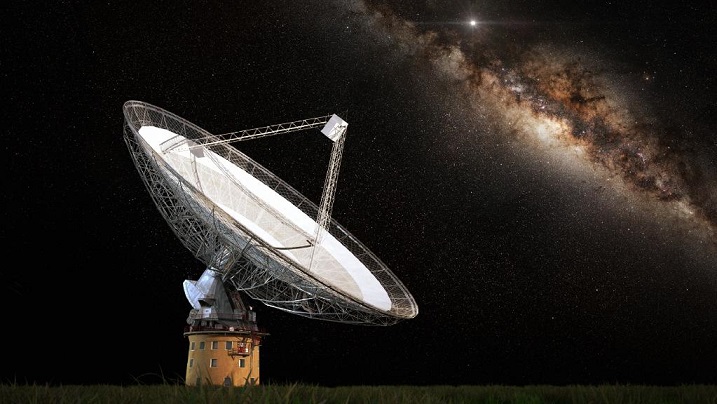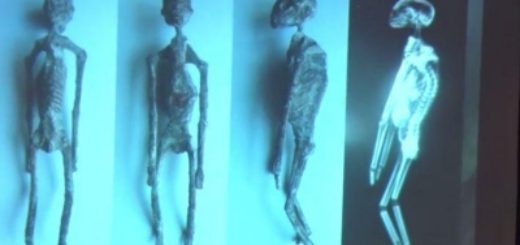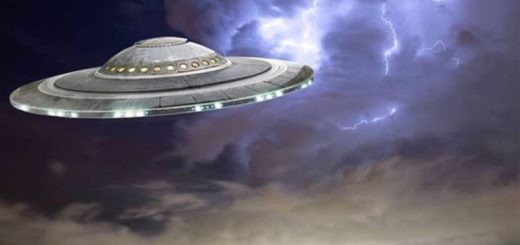Alien-hunting Breakthrough

Alan Boyle
Intriguing radio signals have been picked up via the Green Bank Telescope in West Virginia.
Breakthrough Listen, a $100 million initiative aimed at stepping up the search for alien signals, says it’s picked up an intriguing series of 15 fast radio bursts emanating from a dwarf galaxy 3 billion light-years away.
It’s way too early to claim that the signals from the galaxy, which hosts a radio source known as FRB 121102, constitute the kind of evidence sought for decades by researchers specializing in the search for extraterrestrial intelligence, or SETI.
But Breakthrough Listen’s researchers say that possibility can’t yet be ruled out.
The radio emissions were detected by the Green Bank Telescope in West Virginia on Aug. 26 during a five-hour-long series of 30-minute scans that were conducted as part of the Breakthrough Listen campaign.
Twelve of the blips were recorded during the first scan, and three more came during the second scan. The eight subsequent scans turned up nothing further.
The results were reported Monday evening on The Astronomer’s Telegram. In a news release, Breakthrough Listen said the findings also will be laid out in an upcoming scientific paper.
FRB 121102 was discovered five years ago in the constellation Auriga, and astronomers already knew that it was a source of repeated fast radio bursts, or FRBs. That’s why Breakthrough Listen added the source to its list of targets for observation.
The latest findings are likely to sharpen interest in FRB 121102.
“Bursts from this source have never been seen at this high a frequency,” Andrew Siemion, director of the Berkeley SETI Research Center and the Breakthrough Listen program, said in a news release.
“Whether or not fast radio bursts turn out to be signatures of extraterrestrial technology, Breakthrough Listen is helping to push the frontiers of a new and rapidly growing area of our understanding of the universe around us,” Siemion said.
The cause of such radio emissions is a hot topic of study. The leading candidate would be a rotating neutron star with an extremely strong magnetic field, but astronomers say it’s unlikely that such a star would be found in the type of dwarf galaxy that contains FRB 121102.
Some have speculated that radio bursts could be produced by extraterrestrial civilizations if they used directed energy beams to power light-sail spacecraft. Just such a scenario was proposed several months ago by a couple of astronomers at the Harvard-Smithsonian Center for Astrophysics.
One of the astronomers, Avi Loeb, chairs the advisory committee for Breakthrough Starshot, an initiative that’s related to Breakthrough Listen and aims to send swarms of interstellar probes through the Alpha Centauri system … propelled by directed energy beams.
Seth Shostak, senior astronomer at the California-based SETI Institute, told GeekWire that FRB 121102 is the “one burster that it pays to observe,” because it’s the only source of fast radio bursts that’s been known to repeat.
He cautioned that the findings from FRB 121102 may not apply to other bursters.
“The new data are likely to be helpful in figuring out what’s going on here, but of course it could be that this particular object is a member of an ‘FRB subspecies’ – and not typical of most of these weird cosmic screamers,” Shostak said in an email. “Kind of like hearing things growling in the night, eventually seeing one dog, and deducing that anything that growls is two feet high and has a wet nose.”



 Creators of mankind
Creators of mankind Description of “Tall white aliens”
Description of “Tall white aliens” Where they came from?
Where they came from? About hostile civilizations
About hostile civilizations The war for the Earth
The war for the Earth “Tall white aliens” about eternal life
“Tall white aliens” about eternal life Video: “Nordic aliens”
Video: “Nordic aliens” Aliens
Aliens Alien encounters
Alien encounters The aliens base
The aliens base UFO
UFO Technology UFO
Technology UFO Underground civilization
Underground civilization Ancient alien artifacts
Ancient alien artifacts Military and UFO
Military and UFO Mysteries and hypotheses
Mysteries and hypotheses Scientific facts
Scientific facts


















